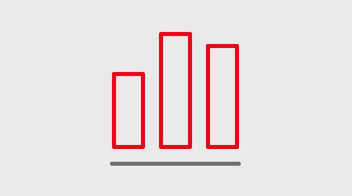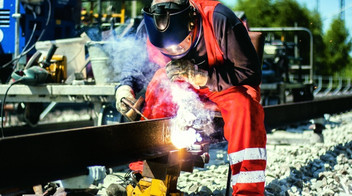Development in the year under review
- Punctuality was severely affected in particular by construction-related capacity restrictions in the infrastructure.
- Noticeable ongoing recovery in demand is leading to a significantly more positive revenue development. Strikes and announcements of strikes had a negative effect.
- Higher expenses for energy and personnel, among other things, had a negative impact on profit development.
- Continued high capital expenditures for the modernization of the vehicle fleet.
DB Long-Distance | 2023 | 2022 | Change | |
absolute | % | |||
Punctuality (%) | 64.0 | 65.2 | –1.2 | – |
Punctuality (whole journey) (%) | 68.9 | 69.3 | –0.4 | – |
Customer satisfaction (grade) | 2.7 | 2.7 | – | – |
BahnCards (thousand) | 5,019 | 5,107 | –88 | –1.7 |
Passengers (million) | 140.3 | 132.0 | +8.3 | +6.3 |
Volume sold (million pkm) | 45,459 | 41,720 | +3,739 | +9.0 |
Volume produced (million train-path km) | 157.7 | 158.9 | –1.2 | –0.8 |
Load factor (%) | 49.1 | 45.9 | +3.2 | – |
Total revenues (€ million) | 5,896 | 4,980 | +916 | +18.4 |
External revenues (€ million) | 5,729 | 4,845 | +884 | +18.2 |
EBITDA adjusted (€ million) | 483 | 389 | +94 | +24.2 |
EBIT adjusted (€ million) | –43 | –39 | –4 | +10.3 |
Gross capital expenditures (€ million) | 1,657 | 1,667 | –10 | –0.6 |
Employees as of Dec 31 (FTE) | 20,966 | 19,139 | +1,827 | +9.5 |
| Employees annual average (FTE) | 20,394 | 18,931 | +1,463 | +7.7 |
Employee satisfaction (SI) | – | 3.6 | – | – |
Share of women as of Dec 31 (%) | 27.2 | 26.7 | +0.5 | – |
Specific final energy consumption compared to 2006 (based on pkm) (%) | –29.8 | –23.1 | –6.7 | – |
The punctuality of DB Long-Distance declined in 2023 compared to the previous year. The reasons for this were, in particular, the poor condition of the rail infrastructure due to outdated and fault-prone facilities, as well as the high volume of short-term construction requirements. In addition, disruptions on the highly utilized sections and transport hubs led to disproportionately high congestion that had an impact on the entire rail network. In addition, the replacement of damaged concrete ties and the associated setting up of restricted speed sections is a core challenge for operational quality. A positive point worth mentioning is that the number of vehicle faults has decreased, while vehicle availability is increasing. As a result, the punctuality (whole journey) was also somewhat weaker.
As part of digitalization, DB Long-Distance switched to an online survey when enquiring about customer satisfaction. In the online survey after the trip, about 150,000 customers were continuously surveyed in 2023 concerning their satisfaction with their long-distance journey. Customer satisfaction did not improve in 2023 due to the difficult operating environment compared to the previous year. After a positive start to the year, customer satisfaction fell in the middle of the year and remained at the previous year’s level despite better assessment of comfort and service due to unsatisfactory punctuality and the strike situation.
Decreasing new sales and increasing cancelation figures as a result of the tense operating situation, among other things, led to a slightly lower number of BahnCards. This affected all types of BahnCard.
The positive trend in performance development continued in 2023:
- Number of passengers and volume sold: Significant increase, driven mainly by recovery effects, as the first quarter of 2022 was still significantly influenced by measures to contain the Covid-19 pandemic. The EVG and GDL strikes and extreme weather conditions had a dampening effect.
- Volume produced: Timetable adjustments due to construction on the network as well as strike-related cancellations resulted in a slight decline.
- Utilization rate: Marked improvement as a result of the increased number of passengers.
The economic trend remained challenging. Revenues increased disproportionately compared to expenses (excluding depreciation), so adjusted EBITDA improved significantly. Due to capital expenditures, depreciation increased very noticeably, and adjusted EBIT therefore developed slightly below the previous year’s level and remained negative.
The income side recorded significant gains:
- Revenues (+18.4%/€ +916 million): Price and performance-related growth were significant. The strike measures had a dampening effect.
- Other operating income (+7.8%/€ +36 million): Increase due to higher compensation payments and positive effects from the transfer of activities from DB Sales. The increase was largely offset by the Federal Government’s lower train-path price reimbursement for the partial compensation of damages in connection with the Covid-19 pandemic.
Expenses increased noticeably, especially as a result of energy cost increases and measures to improve performance quality.
- Cost of materials (+14.0%/€ +427 million): The increase was mainly due to price-related higher energy expenses (partially compensating effects from the electricity price brake are reported in the extraordinary result). Additional increases resulted, for example, from higher costs for inspections and maintenance due to increases in price and quantity, increased project costs (e.g. to improve WiFi quality), higher goods procurement for onboard catering due to higher sales, and increased expenses for vehicle cleaning. Weak operating quality and a higher number of passengers also led to additional customer service expenses.
- Other operating expenses (+36.3%/€ +267 million): The increase resulted, among other things, from the implementation of IT projects and digitalization measures as well as the Group charges introduced in 2023. Furthermore, an increase in employee qualification measures, higher service and project costs, increasing travel activity and the positive performance development, also had the effect of increasing expenses.
- Personnel expenses (+14.2%/€ +180 million): The development resulted mainly from a higher number of employees and from the results of collective bargaining.
- Depreciation (+22.9%/€ +98 million): The increase was due in particular to the expansion of the high-speed fleet and the redesign of ICE 1 and ICE 3 trains. This was counteracted by ICE 2 and Intercity 1 trains reaching the end of their useful life.
Capital expenditures were at the same high level as in the previous year and resulted from continuing vehicle projects.
As of December 31, 2023, the number of employees increased, in particular as a result of implementing measures to improve quality and increase capacity and as a result of the transfer of activities from DB Sales.
The share of women increased slightly.
The decline in specific final energy consumption compared to 2006 (based on pkm) increased further. This improvement is mainly due to the higher capacity utilization. In addition to the utilization of capacity, there has also been a significant improvement in energy efficiency. This is due, among other things, to the continuous sensitization of the traction unit drivers to use the electrodynamic brakes with Intercity 2 (147 series). Training was also carried out for energy-efficient driving. In addition, average consumption was further reduced due to the implementation of numerous measures.


